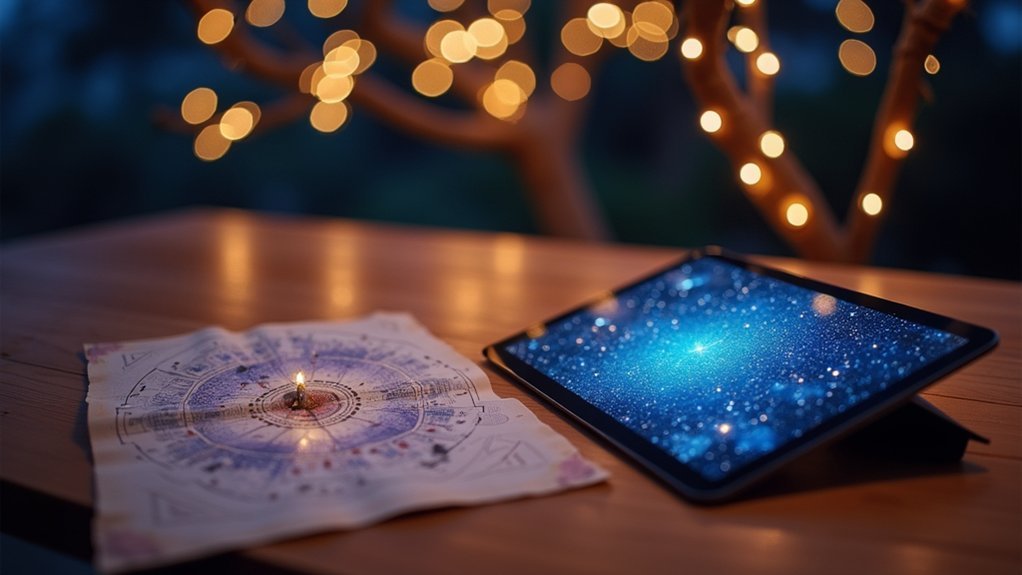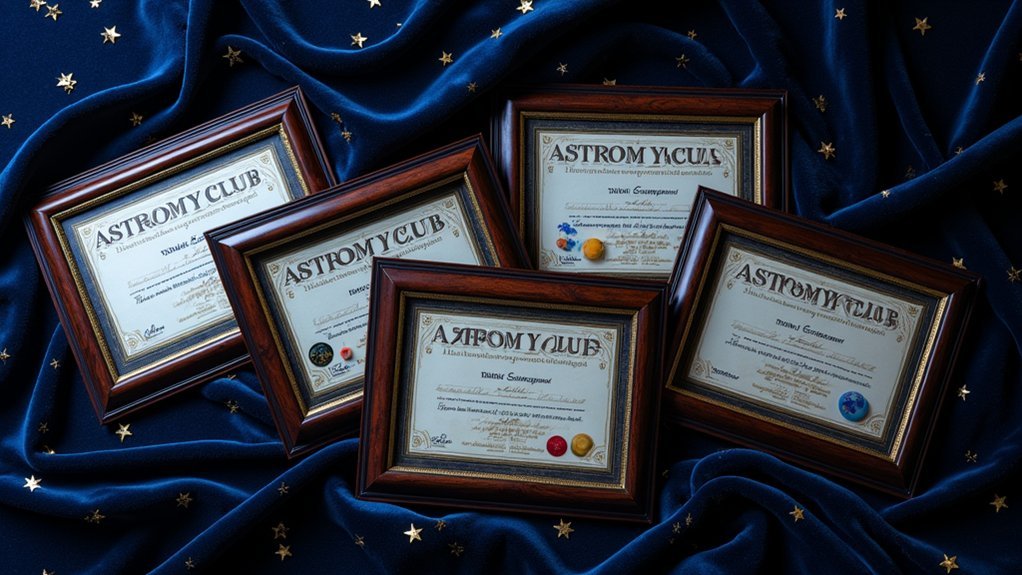Paper star charts offer superior dark adaptation preservation, weather resistance, and never need batteries—perfect for extended observations. Digital apps provide interactive features, real-time tracking, and instant object identification with detailed information. Your best choice depends on your observing style: serious astronomers often use paper charts for learning the sky, while casual stargazers prefer digital convenience. Many experienced observers now combine both methods to maximize their celestial exploration experience.
The Evolution of Star Charts: From Parchment to Pixels

While we now casually navigate the cosmos with a swipe of our screens, humanity’s methods for mapping the stars have undergone a remarkable transformation over millennia.
From prehistoric cave paintings serving as primitive celestial maps to Ptolemy’s systematic constellation designs in 150 AD, star charts have continuously evolved to meet our needs.
Mankind’s celestial cartography has journeyed from ancient cave art to sophisticated digital interfaces, adapting across ages to serve our cosmic curiosity.
The Renaissance revolutionized accessibility when the printing press allowed mass production of star charts for navigation and study.
Amateur astronomers once relied exclusively on paper charts, meticulously plotting their observations by hand.
Today’s digital star charts represent the culmination of this evolution.
Beginning in the late 20th century, modern digital star charts now offer augmented reality features that let you point your device skyward to instantly identify celestial objects based on your location and time.
Key Features of Traditional Paper Star Atlases
Traditional paper star atlases offer exceptional chart clarity with their high-contrast printing that you’ll appreciate during nighttime observations.
You can easily discern fine details of celestial objects thanks to their carefully designed layouts and thoughtful use of symbols that remain visible even in dim red flashlight conditions.
Many quality paper atlases also feature weather-resistant pages that withstand dew and light moisture, ensuring your astronomical reference remains functional throughout unpredictable observing conditions.
Detailed Chart Clarity
Unlike their digital counterparts, paper star atlases excel in providing unmatched visual clarity that helps astronomers of all levels navigate the night sky. When you examine traditional paper atlases, you’ll notice bright stars depicted as larger dots, making their identification intuitive even in low-light conditions.
These detailed charts offer a wealth of information through thoughtfully designed symbols representing various celestial objects like variable stars, double stars, and deep-sky targets. The star maps come in multiple scales and detail levels, allowing you to select the right chart for your specific observing goals.
Without the glare or battery concerns of digital screens, these traditional paper atlases deliver continuous access to astronomical data. The tactile experience of handling physical star maps also reinforces your learning as you trace constellation patterns with your fingertips.
Weather-Resistant Durability
Beyond their visual advantages, paper star atlases prove remarkably resilient under challenging outdoor conditions. Traditional paper star atlases often feature weather-resistant coatings that protect against dew and light rain, ensuring longevity during your stargazing sessions.
| Condition | Paper Atlas | Digital Device |
|---|---|---|
| Rain/Dew | Continues functioning | Risk of damage |
| Battery Life | Never runs out | Limited hours |
| Wind | Easily manageable | Screen issues |
You’ll appreciate the durable construction when observing in unpredictable environments. While digital options require protection and power, tear-resistant pages in quality paper atlases withstand repeated outdoor use without degradation. Their resilience in varying temperatures and humidity levels means your reference material remains accessible regardless of conditions, providing reliability when you need it most.
Digital Star Chart Apps and Programs: Capabilities and Limitations

Digital star charts like SkySafari and Stellarium offer you impressive real-time sky rendering, allowing your device to track celestial objects as they move across the night sky.
You’ll enjoy pointing your smartphone at the heavens to instantly identify stars and planets through augmented reality features not possible with paper charts.
Your stargazing sessions with digital tools will require planning ahead for battery life, especially in remote locations where charging options aren’t readily available.
Real-Time Sky Rendering
When you open a modern star chart application on your device, you’re instantly greeted with a dynamic portrayal of the celestial sphere that mirrors what’s happening overhead at that very moment. This real-time sky rendering transforms your observing experience by allowing you to identify celestial objects as they move across the night sky.
| Feature | Digital Star Chart | Paper Charts |
|---|---|---|
| Movement Tracking | Dynamic, automatic | Static, manual |
| Location Customization | Adjusts instantly | Requires calculations |
| Time Simulation | Available for planning | Not possible |
Unlike their paper counterparts, digital tools like SkySafari and Stellarium offer interactive elements that enhance stargazing. However, these benefits come with trade-offs—potential distractions from notifications and dependence on battery life. When planning extended sessions in remote locations, you might find paper charts more reliable despite their static nature.
Battery Life Concerns
Three critical factors make battery life a significant consideration when choosing digital star charts for your astronomical adventures. Most devices offer only 5-12 hours of operation, which may not cover extended stargazing sessions in remote locations without charging options.
Features like real-time tracking and augmented reality—while impressive—rapidly drain your device’s power reserves.
You’ll need to master power management techniques to maximize your observing time. Enable night mode or battery saver options to reduce screen brightness and limit background processes.
Despite these precautions, device malfunctions or unexpected battery depletion remain real risks that could leave you starless mid-session.
Unlike paper alternatives, digital star charts create a dependency on technology that requires careful planning, especially for all-night observations in areas without power sources.
Practical Considerations for Nighttime Observing Sessions
Preparing for a successful stargazing session requires thoughtful planning beyond simply choosing between paper or digital charts. When observing the night sky, allow at least 20 minutes for your eyes to adapt to darkness—this greatly improves your ability to spot fainter celestial objects.
Amateur astronomy benefits from a focused approach: select a few quality targets rather than attempting to view everything in your star atlases at once.
- The tactile experience of physical star charts creates a deeper connection to the cosmos, free from the distracting blue light of screens.
- Planispheres offer immediate orientation without battery concerns, putting the rotating night sky literally in your hands.
- Digital applications excel when tracking moving celestial objects, providing real-time updates that paper simply can’t match.
Learning Curve Comparison: Mastering Paper vs. Digital Navigation

Although both methods serve the same ultimate purpose, the learning paths for paper and digital star navigation diverge considerably.
With paper star charts, you’ll develop a tactile understanding of the night sky as you manually locate celestial objects using coordinates and symbols. This hands-on approach enhances your observational skills while fostering patience and attention to detail.
Digital navigation tools like SkySafari offer immediate gratification through real-time tracking and augmented reality features. You’ll identify objects faster without prior knowledge of star patterns. However, this convenience comes with risks of information overload if you’re not adept at quickly maneuvering the interface during observations.
The paper method builds deeper sky familiarity and better retention, while digital tools provide engaging interactive features that can simplify the learning curve, especially for beginners.
Dark Adaptation and Battery Life: Critical Field Factors
When venturing into the field for a night of stargazing, two factors can make or break your experience: preserving your dark adaptation and managing power resources.
Paper star charts shine here—they never run out of battery and won’t disrupt the 20-30 minutes your eyes need to fully adapt to darkness.
One glance at a phone screen resets your dark vision—paper charts keep the universe’s treasures visible all night long.
Meanwhile, digital star charts require careful power management, especially during extended sessions when viewing celestial objects.
- Imagine standing under a canopy of stars, your paper chart illuminated by gentle red light, while your friend’s phone dies at the moment of a rare astronomical event.
- Feel the frustration of losing 30 minutes of dark adaptation because of an unexpected bright notification from your digital device.
- Experience the peace of mind knowing your star-finding ability doesn’t depend on a battery percentage.
Hybrid Approaches: Combining Paper and Digital Resources

While traditionalists and tech enthusiasts often debate the superiority of their preferred star chart medium, many experienced astronomers have discovered that the best approach lies in combining both paper and digital resources. This hybrid approach enhances your stargazing experience by leveraging the strengths of each format.
| Paper Resource | Digital Complement |
|---|---|
| Pocket Sky Atlas | SkySafari app for real-time tracking |
| Bright Star Atlas | Digital planetarium for deep-sky objects |
| Glow-in-dark planisphere | Smartphone apps without affecting night vision |
| Seasonal star charts | Apps showing current celestial events |
You’ll develop stronger celestial navigation skills using physical charts while gaining precision from digital tools. During observing sessions, try pairing a planisphere with a digital app—use the paper chart for broad orientation, then switch to digital for detailed information on specific objects.
Frequently Asked Questions
What Is the Best Star Chart for Beginners?
For beginners, you’ll want “Turn Left at Orion” for its easy-to-follow approach or the “Sky & Telescope Pocket Sky Atlas” for clear charts. Digital options like SkySafari offer interactive experiences if you’re tech-savvy.
How Accurate Is Star Chart?
Star charts are highly accurate when they match your location and time. You’ll find digital versions more precise as they’re regularly updated, while paper charts can have projection distortions but remain reliable navigational tools.
What Is the Best Star Atlas for Beginners?
For beginners, “Turn Left at Orion” is your best star atlas choice. It’s specifically designed with novice astronomers in mind, offering easy-to-follow charts and sketches that’ll help you locate celestial objects with confidence.
How Do I Know Which Star I’m Looking At?
You’ll identify stars by using a star map matched to your location and season. Start with bright stars as landmarks, then use star-hopping techniques to navigate. Note that stars twinkle while planets show steady light.
In Summary
You’ll likely find that neither paper nor digital star charts are definitively “better” for all situations. Your specific needs, observing style, and technological comfort will determine what works best. Consider embracing a hybrid approach—keeping paper charts as reliable backups while leveraging digital tools’ interactive features. What matters most isn’t the medium you choose, but how effectively it connects you to the wonders above.





Leave a Reply